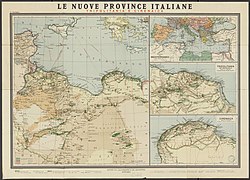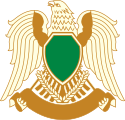| History of Libya | ||||||||||||||||||||||||||||||||||||||
|---|---|---|---|---|---|---|---|---|---|---|---|---|---|---|---|---|---|---|---|---|---|---|---|---|---|---|---|---|---|---|---|---|---|---|---|---|---|---|
 | ||||||||||||||||||||||||||||||||||||||
|
||||||||||||||||||||||||||||||||||||||
|
| ||||||||||||||||||||||||||||||||||||||
 |
|---|
From 1969 to early 2011, the politics of Libya were determined de facto by Muammar Gaddafi, who had been in power since his overthrow of the Kingdom of Libya in 1969.
Gaddafi abolished the post-1951 Libyan Constitution and introduced his own political philosophy, based on his Green Book published in the 1970s.[1] Gaddafi's system was known as Jamahiriya and was notionally legally based on the legislative General People's Congress (GPC), consisting of 2,700 representatives of Basic People's Congresses, and the executive General People's Committee, headed by a General Secretary.
An essential part of Gaddafi’s political philosophy can be summed up in this excerpt from his Green Book:
“A parliament is originally founded to represent the people, but this in itself is undemocratic as democracy means the authority of the people and not an authority acting on their behalf. The mere existence of a parliament means the absence of the people. True democracy exists only through the direct participation of the people, and not through the activity of their representatives.”
The Jamahiriya Sector was overseen by the Revolutionary Sector. This was headed by Muammar Gaddafi as "Brotherly Leader of the Revolution", the Revolutionary Committees, and the surviving members of the 12-person Revolutionary Command Council established in 1969. This "revolutionary sector" held office by virtue of having led the revolution and therefore was not subject to election. As a consequence, although Gaddafi held no governmental post after 1980, he maintained absolute control over the country until the collapse of his regime during the Libyan Civil War.
- ^
Country Profile: Libya (PDF). Library of Congress Federal Research Division (April 2005).
 This article incorporates text from this source, which is in the public domain.
This article incorporates text from this source, which is in the public domain.
© MMXXIII Rich X Search. We shall prevail. All rights reserved. Rich X Search
